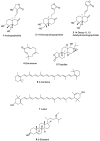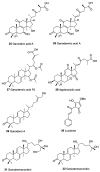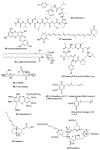Antitumor Potential of Immunomodulatory Natural Products
- PMID: 35736189
- PMCID: PMC9229642
- DOI: 10.3390/md20060386
Antitumor Potential of Immunomodulatory Natural Products
Abstract
Cancer is one of the leading causes of death globally. Anticancer drugs aim to block tumor growth by killing cancerous cells in order to prevent tumor progression and metastasis. Efficient anticancer drugs should also minimize general toxicity towards organs and healthy cells. Tumor growth can also be successfully restrained by targeting and modulating immune response. Cancer immunotherapy is assuming a growing relevance in the fight against cancer and has recently aroused much interest for its wider safety and the capability to complement conventional chemotherapeutic approaches. Natural products are a traditional source of molecules with relevant potential in the pharmacological field. The huge structural diversity of metabolites with low molecular weight (small molecules) from terrestrial and marine organisms has provided lead compounds for the discovery of many modern anticancer drugs. Many natural products combine chemo-protective and immunomodulant activity, thus offering the potential to be used alone or in association with conventional cancer therapy. In this review, we report the natural products known to possess antitumor properties by interaction with immune system, as well as discuss the possible immunomodulatory mechanisms of these molecules.
Keywords: anticancer; antitumor; immunomodulators; marine products; natural products.
Conflict of interest statement
The authors declare no conflict of interest.
Figures







Similar articles
-
Therapeutic Application of Diverse Marine-derived Natural Products in Cancer Therapy.Anticancer Res. 2019 Oct;39(10):5261-5284. doi: 10.21873/anticanres.13721. Anticancer Res. 2019. PMID: 31570422 Review.
-
Marine anticancer drugs and their relevant targets: a treasure from the ocean.Daru. 2019 Jun;27(1):491-515. doi: 10.1007/s40199-019-00273-4. Epub 2019 Jun 5. Daru. 2019. PMID: 31165439 Free PMC article. Review.
-
Exploring Marine Alkaloids: A Natural Approach to Cancer Treatment.Curr Pharm Biotechnol. 2025;26(1):63-79. doi: 10.2174/0113892010316791240611093022. Curr Pharm Biotechnol. 2025. PMID: 38918975 Review.
-
The Phylum Bryozoa as a Promising Source of Anticancer Drugs.Mar Drugs. 2019 Aug 17;17(8):477. doi: 10.3390/md17080477. Mar Drugs. 2019. PMID: 31426556 Free PMC article. Review.
-
Novel Marine Secondary Metabolites Worthy of Development as Anticancer Agents: A Review.Molecules. 2021 Sep 23;26(19):5769. doi: 10.3390/molecules26195769. Molecules. 2021. PMID: 34641312 Free PMC article. Review.
Cited by
-
Immunoenhancing Effects of Cyclina sinensis Pentadecapeptide through Modulation of Signaling Pathways in Mice with Cyclophosphamide-Induced Immunosuppression.Mar Drugs. 2022 Aug 31;20(9):560. doi: 10.3390/md20090560. Mar Drugs. 2022. PMID: 36135750 Free PMC article.
-
Natural products modulate cell apoptosis: a promising way for treating endometrial cancer.Front Pharmacol. 2023 Jun 8;14:1209412. doi: 10.3389/fphar.2023.1209412. eCollection 2023. Front Pharmacol. 2023. PMID: 37361222 Free PMC article. Review.
-
Cytotoxic and immunomodulatory properties of Tinospora cordifolia, Boerhaavia diffusa, Berberis aristata, and Ocimum basilicum extracts against HPV-positive cervical cancer cell line.BMC Complement Med Ther. 2025 Feb 17;25(1):59. doi: 10.1186/s12906-025-04817-x. BMC Complement Med Ther. 2025. PMID: 39962423 Free PMC article.
-
Nature-Inspired Strategies in Cancer Management: The Potential of Plant Extracts in Modulating Tumour Biology.Int J Mol Sci. 2025 Jul 18;26(14):6894. doi: 10.3390/ijms26146894. Int J Mol Sci. 2025. PMID: 40725141 Free PMC article. Review.
-
Anticancer therapeutic potential of genus Diospyros: From phytochemistry to clinical applications-A review.Food Sci Nutr. 2024 Aug 13;12(10):7033-7047. doi: 10.1002/fsn3.4375. eCollection 2024 Oct. Food Sci Nutr. 2024. PMID: 39479648 Free PMC article. Review.
References
Publication types
MeSH terms
Substances
LinkOut - more resources
Full Text Sources
Medical

